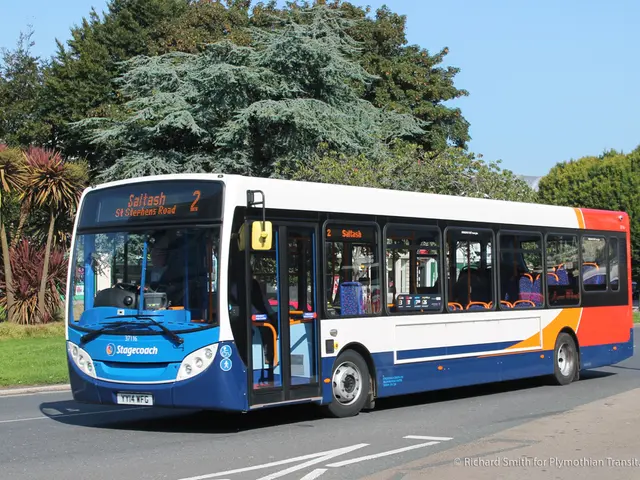Eu-enforced automotive safety technology may exhibit unreasonable, erratic behavior, potentially threatening public safety, caution experts
The European Union's Driver Drowsiness and Attention Warning (DDAW) systems, mandated by the General Safety Regulation (GSR), are set to revolutionise road safety by addressing the issue of drowsy driving. These systems, due to be installed in all new models from July 2024, aim to reduce accidents caused by drowsy driving, which account for 10-25% of road accidents in Europe.
DDAW systems use in-car cameras that monitor the driver's eyes and posture to detect if they're falling asleep or distracted at the wheel. They are designed to automatically detect driver drowsiness (at Level 8+ on the Karolinska Sleepiness Scale) and provide alerts when vehicles exceed 70 km/h. Volvo was one of the first car manufacturers to introduce DDAW systems, in their EX90 model in 2022.
While the effectiveness of these systems is anticipated to have a significant impact on safety, there are concerns about implementation and acceptance within the industry. Some drivers and transport companies have expressed resistance, partly due to the lack of direct insurance incentives for equipping vehicles with such safety tech. Education and communication about the benefits of DDAW systems are key to gaining driver buy-in.
The success of DDAW systems will also depend on accurate detection, user interface quality for alerts, and the avoidance of false positives or nuisance alarms. Related technologies, like remote camera monitoring for fatigue detection, can be labor-intensive and challenging to scale, highlighting a potential gap in addressing driver fatigue comprehensively beyond DDAW systems.
In the UK, the Government is likely to apply the EU's GSR2 regulations to British-sold motors to prevent higher costs of production being passed on to buyers, as per Sir Keir Starmer's Government's statement last month. However, some recent tests by What Car? have raised concerns about the effectiveness and intrusiveness of these systems. Tests on six brand new cars found DDAW systems to be 'irrational and erratic', potentially putting lives at risk. The Chinese Leapmotor C10, a family SUV, received a low one-star rating due to its DDAW system issuing three false alarms when the test driver was looking at the road ahead during tests.
What Car? has urged Euro NCAP to 'penalise systems that are poorly integrated into cars instead of simply rewarding manufacturers for including the technology'. Drivers can turn off DDAW systems, but they will need to deactivate each or a group of the safety features before every journey. This continuous stream of beeps and visual alerts can become so annoying during tests that drivers are likely to turn them off at the start of each journey.
Despite these challenges, the EU's DDAW systems represent a significant regulatory step expected to materially enhance road safety by mitigating drowsy driving risks. The projected safety benefits are substantial and supported by data on fatigue-related crashes. The system’s success will depend on effective roll-out, driver compliance, and integration with complementary safety strategies.
[1] European Commission. (2021). Safety regulation for vehicles: The General Safety Regulation (GSR). [online] Available at: https://ec.europa.eu/transport/road_safety/gsr/index_en.htm [2] What Car? (2023). What Car? tests DDAW systems in six new cars and finds them 'irrational and erratic'. [online] Available at: https://www.whatcar.com/news/what-car-tests-ddaw-systems-in-six-new-cars-and-finds-them-irrational-and-erratic/179242 [3] European Transport Safety Council. (2022). Driver Drowsiness and Attention Warning Systems: Benefits, Challenges and Opportunities. [online] Available at: https://etsc.eu/publications/driver-drowsiness-and-attention-warning-systems-benefits-challenges-and-opportunities/ [4] European Commission. (2022). Driving Safety: The role of driver assistance systems. [online] Available at: https://ec.europa.eu/transport/road_safety/driving_safety/driving_safety_en.htm
- The European Commission's General Safety Regulation (GSR) is poised to transform the automotive industry, with DDAW systems mandated for all new vehicles from 2024, aiming to reduce drowsy driving accidents in the EU. (European Commission, 2021)
- While technology has the potential to improve road safety through DDAW systems, concerns about implementation and acceptance within the finance and insurance sectors persist, as direct incentives for equipping vehicles with safety tech are presently absent. (European Transport Safety Council, 2022)
- As the industry moves towards increased use of technology for driver safety, complementary strategies such as robust insurance policies and education programs on DDAW system benefits will be crucial to ensure high levels of driver compliance, leading to significant improvements in overall road safety. (European Commission, 2022)




